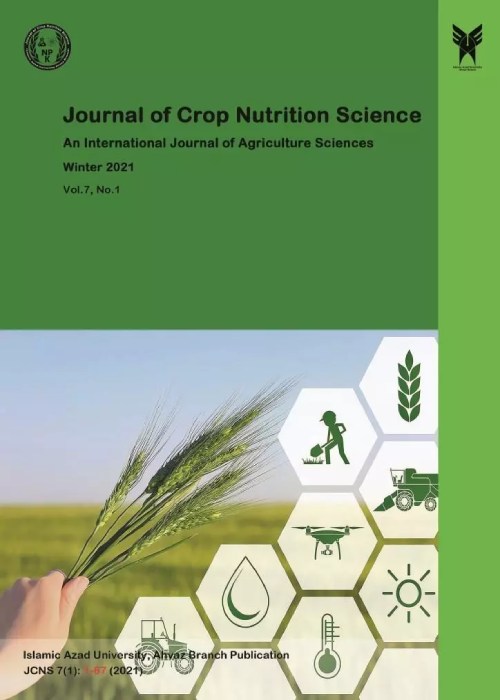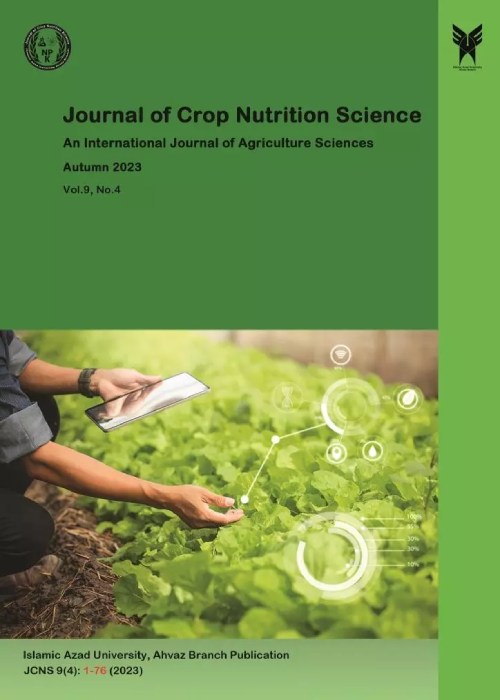فهرست مطالب

Journal of Crop Nutrition Science
Volume:7 Issue: 1, Winter 2021
- تاریخ انتشار: 1400/01/11
- تعداد عناوین: 6
-
Pages 1-21BACKGROUNDUnder water deficit conditions, use of growth-promoting bacteria and salicylic acid as a plant growth stimulant is very useful.OBJECTIVESThis research was conducted to assess effects of biological fertilizers and salicylic acid under non-irrigation conditions at different growth stages on growth indices and crop production of corn during 2016 cropping season.METHODSThe study was done via split-plot experiment, based on Randomized Complete Block Design with three replications. The treatments included full irrigation (control), non-irrigation from flowering stage to the end of growth period, non-irrigation from the beginning of the grain filling stage to the end of the growth period, belonged to main plots and biological fertilizers and salicylic acid treatment were placed in sub-plots [control treatment, 1 mM salicylic acid, nitroxin + biophosphorus bacteria grain rub, nitroxin + biophosphorus bacteria grain rub along with salicylic acid spraying].RESULTThe results showed that the full irrigation treatment significantly improved the growth physiological indices such as the leaf area index. The combination of nitroxin, biophosphorus and salicylic acid had a positive and significant effect on the examined indicators. The effects of non-irrigation treatments, biological fertilizers, salicylic acid and their interaction effect on grain yield were significant. Non-irrigation from flowering stage reduced the grain yield by 58.3% compared to the control. The combined application of biological fertilizers + salicylic acid in treatments of non-irrigation and full irrigation significantly increased the grain yield. In the treatment of non-irrigation from flowering and early grain filling, the nitroxin + biophosphorus + salicylic acid bacteria treatment increased the grain yield by 22.7% and 19.3%, respectively, compared to the control. The maximum grain yield (6552 kg.ha-1) belonged to the full irrigation treatment and nitroxin + biophosphorus + salicylic acid foliar application.CONCLUSIONIn case of non-irrigation during grain filling stage, by use Nitroxin + biophosphorus bacteria grain rub treatment along with salicylic acid foliar application, also to provide suitable conditions for corn growth, a significant amount of drought stress effect can be reduced and obtained yield under normal conditions.Keywords: Biofertilizer, growth curve, Maize, Nitroxin, Seed yield
-
Pages 22-29BACKGROUNDOrganic farming has emerged as an important priority area globally in view of the growing demand for safe and healthy food and long term sustainability and concerns on environmental pollution associated with indiscriminate use of agrochemicals.OBJECTIVESThis study was done to determine effect of different level of biofertilizer on phenological, morphological and seed yield characteristics of corn genotypes.METHODSCurrent research was conducted as split plot in randomized complete bock design with three replications in Payamnoor university of Ilam in 2009-2010. Treatments were cultivar (SC604, SC704 and SC807) as main plots and rhizobacteria (non- inoculation, inoculation with Azetobacter, Azospirillum and dual inoculation of Azotobacter and Azospirillum) as subplots.RESULTThe effect of cultivar on day to maturity, plant height, stem diameter, dry to matter and grain yield was significant. SC 704 had the highest, day to maturity, plant height, dry to matter and grain yield. The effect of plant growth promoting rhizobacteria on all traits was significant. Dual inoculation of Azotobacter and Azospirillum had the highest ear initiation day to ear, day to maturity, plant height, stem diameter, dry to matter and grain yield. Obtained results show that double- inoculation was the most effective treatment in all cultivars. Other effective treatment were Azotobacter and Azospirillum inoculation, separately This is indicated that using growth prompting fertilizers as double- inoculation caused to increasing maize yield through synergistic effects by improving growth prompting hormones, controlling pathogenesis and growth reducing agents due to producing fungicide antibiotics and compounds (antagonistic effect) and also air molecular nitrogen fixing and also producing growth prompting hormones such as oxine, cytokenine and giberlines and solving mineral compound.CONCLUSIONThe highest and lowest grain yield obtains from SC 704 with dual inoculation of Azotobacter and Azospirillum and SC 604 with non-inoculation treatment, respectively. Also studied cultivars showed different responded to most parameters.Keywords: Biofertilizer, corn, dry weight, Grain yield, Nutrition
-
Pages 30-41BACKGROUNDSince several decades ago, many attempts have been made to increase crop production. Use of chemical fertilizers is one of these strategies that have increased crop production and fertilizers management is a necessary strategy for achieving sustainable agriculture.OBJECTIVESCurrent study was done to soil application, use in irrigation water, and foliar application of Fe and Zn on grain yield and their absorption in maize of Dezful city.METHODSA split plot experiment was conducted with the main factor in randomized complete block design to study various application methods of iron and zinc chelates on SC701 hybrid maize, and the extent of which they can be absorbed by plant in two years. The main plot treatment was fertilizer application methods (FAM) including soil application (SA), foliar application (FA) and use in irrigation water (IW). The subplot treatment was type of fertilizer used (TFU) including iron chelate (IC), zinc chelate (ZC), and control treatments (CT). Traits like plant height, 1000-grain weight, grain yield, number of grains per row, plant iron and zinc contents, and grain protein percentage were measured in the experimental and control treatments.RESULTAccording result of ANOVA for Main factor FAM indicated that there were significant differences only on plant height at a probability level of 99%. For the subplot factor TFU except for grain raw protein content, had significant effects on plant height with probability level of 95% and on 1000-grain weight, grain yield, and plant iron and zinc contents with probability level of 99%. The highest iron content in the plant was obtained in the treatment SA, IC in the first and second year 30.25 and 38 mg.kg-1 respectively and the highest amount of zinc, in the SA, ZC in the second year was 33.25 mg.kg-1, 1000-grain weight FA, IC was 385 g and grain yield in the treatment of FA, ZC was obtained 5.22 kg.ha-1.CONCLUSIONThe highest effect of fertilization was in the treatment FA, ZC amount of 163.33 compared to the control in the second year. The results showed that the addition of iron and zinc fertilizer in the soil due to time consuming, is absorbed at the end of plant growth time, which in turn will not increase the 1000-seed weight and grain yield.Keywords: Corn, Foliar application, Soil application, Fertilizer, Nutrition
-
Pages 42-56BACKGROUNDDrought stress is known as the most important factor limiting the growth and crop production. Therefore, the selection of genotypes that has higher yield stability in good crops can play a significant role and impact in the development of rapeseed cultivation with acceptable economic performance in the country.OBJECTIVESCurrent study was carried out to assess effect of terminal drought stress on seed yield and its components of Rapeseed cultivars.METHODSAn experiment was performed as a factorial split plot and in the form of a randomized complete block design with three replications. Irrigation treatment included normal irrigation (irrigation after 80 mm of evaporation from Class A pan) and irrigation cut-off from the pod formation stage onwards in the main plots, planting dates including September 26 and October 26 and four rapeseed cultivars including Tassilo, Elvise, Neptune, and Okapi were evaluated in a factorial form in sub-plots.RESULTThe results revealed that irrigation cut-off and delay in planting date had a significant effect on reducing plant height, number of sub-branches per plant, number of pods per plant, number of grains per pod, and 1000-grain weight. Cultivars were significantly different in terms of all evaluated traits. Elvise and Neptune cultivars had the highest grain yield with (3346) and (3220 kg.ha-1), respectively, under normal irrigation conditions and with a mean of (3211) and (3081 kg.ha-1), respectively, under irrigation cut-off conditions. This advantage was mainly due to an increase in the tank capacity of the yield components. Therefore, Elvise and Neptune cultivars can be introduced with acceptable production stability under normal irrigation conditions and water stress conditions after silique formation.CONCLUSIONAmong the studied cultivars of rapeseed, under normal irrigation and cut-off of irrigation conditions on both planting dates of Sep. 26 and Oct.26, Elvise cultivar showed the highest grain yield per unit area of production and good compatibility. The mentioned cultivar can be recommended in the areas similar to the studied area (Karaj), where there is a possibility of water stress in the late stages of growth.Keywords: Canola, Grain yield, Irrigation, planting dates, Seed Oil content
-
Pages 57-67BACKGROUNDDeviation from Optimum Percentage (DOP) Method is one of the most prominent procedures in order to evaluation of almond nutritional balance.OBJECTIVESThe aims of current research were to determine the nutritional requirement of almond orchards on saman area of Chaharmahal va Bakhtiari Province.METHODSIn order to evaluation nutritional balance of almond trees, an experiment was designed utilizing the Deviation from Optimum Percentage (DOP) technique. This was conducted in the orchards of Zayandehroud River with a length of 60 km, and an information database was accommodated. In current research, 36 gardens were selected and the leaf samples were prepared. The selected leaf samples were deterged and squelched for proving ground analysis. The high yield orchards were selected to provide reference data at the end of growth period and on this subject, 30% of high yield gardens were chosen.RESULTThe DOP indicators were evaluated and the nutritional requirements arrangement was assigned. The findings revealed that the trees nutritional requirements were in the following order: Cu>S>Zn>Mn>P>Ca>Mg>B>N>K>Fe>Mo.CONCLUSIONThe final repercussions exhibited that among the considered nutrients, the highest and least nutrient shortage was dedicated to copper and molybdenum, respectively.Keywords: DOP, Almond Gardens, Nutrition, Chaharmahal va Bakhtiari province, DRIS method
-
Pages 68-76
Manure plays an important role in improving physical, chemical and biological properties of the soil. Manures contain a low concentration of plant nutrients and they have a slow acting nature, organic manure alone may fail to tend the high nutritional requirements of crops. Organic manures including sheep manure, cattle manure and hen manure may be used for crop production as substitute of chemical fertilizers because the importance of organic manures cannot be overlooked. Organic farming has emerged as an important priority area globally in view of the growing demand for safe and healthy food and long term sustainability and concerns on environmental pollution associated with indiscriminate use of agrochemicals. Though the use of chemical inputs in agriculture is inevitable to meet the growing demand for food in world, there are opportunities in selected crops and niche areas where organic production can be encouraged to tape the domestic export market. Farmyard manure (FYM) is an important organic resource for agricultural production in livestock-based farming systems in the semi-arid regions. FYM refers to the decomposed mixture of dung and urine of farm animals along with their litter and fodder fed to the cattle. FYM is one of the components of Integrated Nutrient Management (INM) as it a cheap and easily available source of organic nutrients. Integrating Farmyard Manure with inorganic fertilizer, scientists are getting a very good response to the crop. The application of this source of organic improves the physical, chemical and biological condition of the soils. FYM can supply all the nutrients required by the plant and it is prepared by using cow dung, cow urine, waste straw, and other dairy wastes.
Keywords: Biofertilizer, crop production, Nutrition, organic matter, Soil fertility


